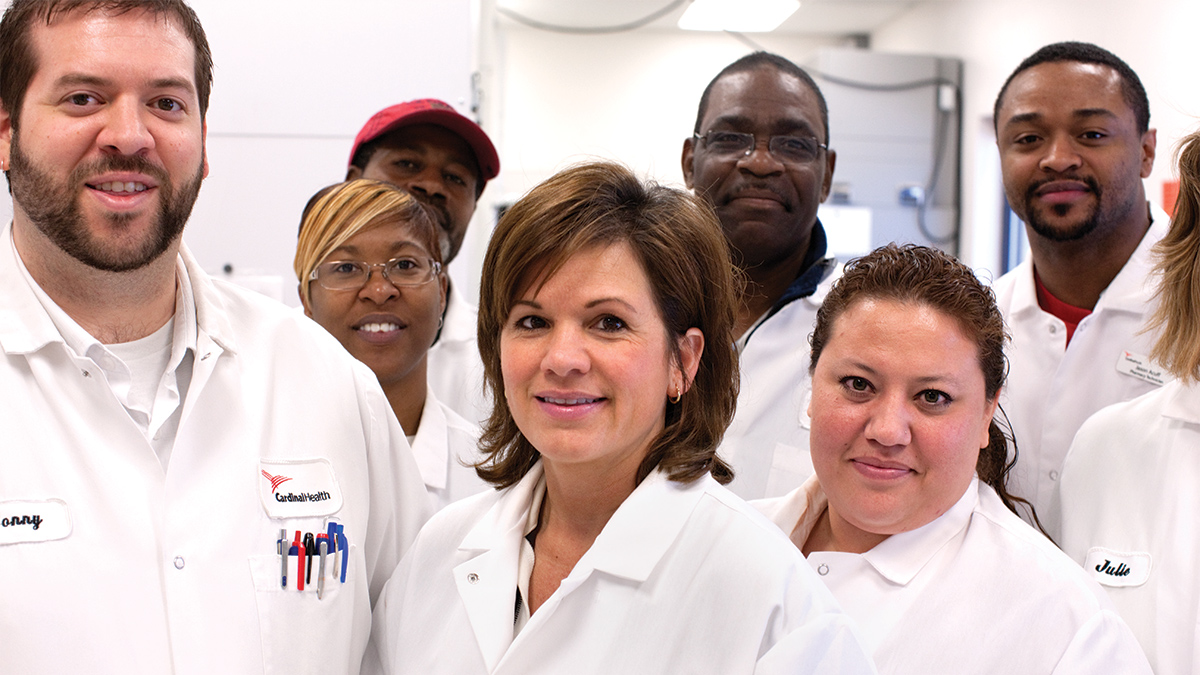Accurate and efficient sharing of patient data across multiple and disparate information systems is at the heart of improving care — as well as meeting the mandate for Electronic Health Records (EHR). Data automation improves efficiency and accuracy, frees up labor capacity and above all, enhances patient safety. In nuclear medicine, it is a new path to achieve the most important goal of all: improving patient outcomes. And at Catholic Medical Center (CMC), that path is leading to a brighter future.
The challenge is to not only meet the data automation needs of today, but also anticipate those of tomorrow. For CMC, the solution is Syntrac™ Integration Tools from Cardinal Health. “We can’t know the issues of the future,” said Bryon Scott, Supervisor, Technical Product Management for Cardinal Health. “But with this system, Catholic Medical Center can better prepare for them now.”

A legacy of leadership
For more than 20 years, CMC and Cardinal Health have worked together to meet new challenges.
CMC had been using Syntrac™ 2.7 (the original nuclear medicine practice management software product offered by Cardinal Health prior to Syntrac™ Integration Tools), so the medical center was an ideal candidate to beta test the new system, a fundamentally new way to meet the growing data automation challenges of healthcare.
What is Syntrac™ Integration Tools?
Syntrac™ Integration Tools helps nuclear medicine and imaging facilities work more efficiently and safely, while maintaining regulatory compliance. “The system helps us meet the demands of the job — streamlining our workload and removing redundant steps, paperwork and man hours,” said Dan Morin, Chief Nuclear Medicine Technologist at CMC. Syntrac™ Integration Tools is the only software system that fully integrates nuclear medicine department management with the ordering and receipt of radiopharmaceutical prescription orders, according to Scott. “This unique combination allows for tighter integration,” he said. And that integration enables far greater efficiency, productivity, accuracy and safety than would be possible otherwise.
Enhancing daily operations
“Syntrac™ Integration Tools is an enabler that helps our customers provide efficient, responsible and confident care,” said Sandra Wisniewski, Vice President of Marketing Management, Strategy and Product Development for Cardinal Health. The aim is to improve the nuclear medicine department’s operations all day, every day. It starts the moment the department opens in the morning. “Before we started using this system, it would take an hour and a half to get the department ready for the day. Now, we do it in half the time,” Morin said.
See how the system continues to streamline every process throughout the day.



- Patient scheduling is in Syntrac™ Integration Tools when NMT arrives in the morning Automatic data transfer from scheduling system to Syntrac™ Integration Tools
- NMT places prescription orders from Syntrac™ Integration Tools to Cardinal Health pharmacy
- Prescription order arrives
- Prescription order delivered to customer
- Customer unpacks prescription order
- Prescription order receipts are downloaded
- Electronic package information sent from pharmacy to Syntrac™ Integration Tools
- NMT administers dose, images patient, etc.
- Radiology Safety Officer/Health Physicist/NMT perform required tests and surveys
- Invoices are paid electronically and prescriptions for tomorrow are sent from scheduling system
- EDI invoices sent from pharmacy to customer accounts payable system
- Prescription orders from Syntrac™ Integration Tools sent electronically to pharmacy
Automating the ordering process with Web Ordering Workflow and SyntracTM Integration Tools
They save time and effort by automating and integrating patient scheduling and inventory receiving. And the Health Physics Module easily tracks regulatory compliance — plus performs survey and tests.
Web Ordering Workflow and Syntrac™ Integration Tools also automate the ordering process, based on patient schedule. So regular orders no longer have to be called in or faxed to the pharmacy, which reduces data entry and errors. "When we ordered by phone in the past, we had no record of the call," Morin added. "Now that we have an automatic record of every order, it helps resolve any discrepancies faster and easier."
The system also improves operations outside CMC's nuclear medicine department — streamlining invoice processing via Web Ordering Workflow (to create electronic invoices). The system can also accommodate EDI integration, which sends invoices directly to the accounts payable system.
Increasing efficiency
Before Syntrac™ Integration Tools, transferring patient data between IT systems was handled by phone and fax. That required technologists to manually rekey information every time a transfer occurred, taking a lot of time and opening the door to duplicate entries and errors. CMC uses Syntrac™ Integration Tools to automate data management via an easy-to-use computer interface that connects hospital IT systems, seamlessly transferring patient data as needed. A technologist need only access a patient’s name from a simple menu and the patient data is there. Syntrac™ Integration Tools also connects all other data needs as well, integrating patient scheduling, online ordering, inventory management and much more. The net result: CMC can make better use of staff time. “Now we can do more with less staff,” Morin said. “Because data reentry is no longer necessary, we can get more done. Technologists don’t want to be clerks; they want to be technologists,” he said. Syntrac™ Integration Tools gives them the freedom to focus more on patient care.
Improving accuracy
The goal is to provide the right dose to the right patient at the right time. Greater accuracy saves time and money, while improving the quality of care. And better data is the key to it all. “Data integrity is one of the biggest issues,” said Michael Cloutier, Director, Technical Services and Imaging Informatics for CMC. “And there’s data everywhere,” as the nuclear medicine IT system connects and transfers information to other IT systems throughout the medical center. “If left to individuals to enter the data, there’s the opportunity for error,” he said. And those errors can begin with the simplest and yet most critical transfers of information, such as typing the patient’s name correctly. Syntrac™ Integration Tools accurately shares the correct information across all systems — from tracking patient data by dose to ordering and tracking radionuclides for the department.
Keeping the information consistent is critical so that everything matches, from entering patient information on the front end to billing on the back end. “That’s how we know who they are, what we did, and how much to bill,” Cloutier said. It is no longer necessary, we can get more done. Technologists don’t want to be clerks; they want to be technologists,” he said. Syntrac™ Integration Tools gives them the freedom to focus more on patient care. Prior to getting Syntrac™ Integration Tools, there were frequent calls because of incorrect data entry, and Cloutier’s team would have to take the time to fix the errors. Now, adding new information to a patient’s record is as simple as selecting the patient’s name in the system. “I can’t remember the last time we had a data entry issue,” he said. “This system is an excellent opportunity to increase workflow efficiency, while reallocating staff time to patient care, instead of clerical functions. The app simply runs as a service in the background,” Cloutier said.
Strengthening safety
In addition to improving accuracy, Syntrac™ Integration Tools also helps improve patient safety. The system uniquely identifies individual patients and automatically tracks dosing information by organ exposure, as prescribed by the physician. By doing so, the system monitors total body exposure. “To do this manually would be a huge job,” Scott said. “It also gives physicians greater confidence.” The system also improves safety by recording established limits for dosing and automatically warning if those limits are exceeded. Prior to Syntrac™ Integration Tools, there would be no warning.
Ensuring compliance
The more nuclear medicine has evolved, the more complex the regulatory environment has become. Today, there are more regulations, from department operations to billing. Because Syntrac™ Integration Tools creates greater transparency and accountability, CMC can have the confidence of knowing that the application will help maintain compliance with state and federal regulations, as well as accrediting agency requirements. “Nuclear medicine departments are more regulated than others,” Scott said. “There’s much more documentation required.” Syntrac™ Integration Tools helps manage the additional burden. “I’m looking for the easiest, best way to complete the job. And that leads to higher compliance,” Morin added. “Syntrac™ Integration Tools gives us a level of regulatory oversight that helps us meet all the required steps correctly. That’s critical when there are unannounced visits from the regulators.
Forward to the future
“Cardinal Health is a good, strong company,” Morin said. “They help us give our patients the best we can give them, while making our lives easier.” Syntrac™ Integration Tools is just one of many solutions that Cardinal Health provides to help nuclear medicine departments become more efficient—streamlining processes, systems and information. By helping staff remain safe and compliant, providers can serve patients responsibly. And by continually introducing new innovations such as Syntrac™ Integration Tools, Cardinal Health helps providers work confidently today, and tomorrow. “We call it ‘making possibilities possible,’” Wisniewski said. And that vision guides the continued collaboration of CMC and Cardinal Health, as together they look forward to the future.
Download this case study.
About Catholic Medical Center
Founded more than 100 years ago, Catholic Medical Center (CMC) is one of New Hampshire’s largest medical centers. CMC is home to the New England Heart Institute, the site of New Hampshire’s first open heart surgery in 1978 and a nationally recognized center of excellence in the diagnosis and therapeutic management of cardiovascular disease. In 2002 the hospital was one of the first in New England to use a state-of-the art robotic surgical system for minimally invasive procedures, and continues to lead the region in medically advanced techniques and technology that improve patient care. CMC is also home to The Obesity Treatment Center — a designated Bariatric Surgery Center of Excellence — plus the Breast Care Center, Cholesterol Management Center, Diabetes Resource Institute, The Mom’s Place, New England Sleep Center, Obesity Treatment Center, Surgical Care Group, Urgent Care at Bedford, The Wellness Center, Wound Care Center and a network of area primary care physicians.

